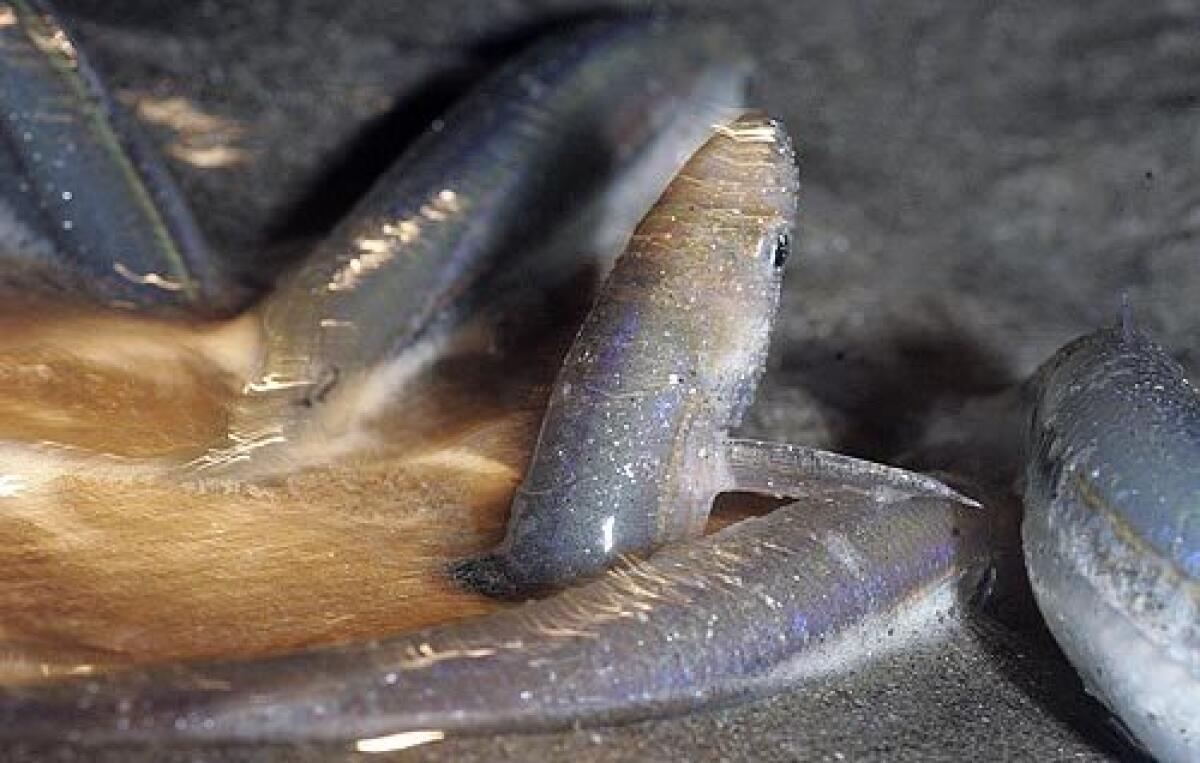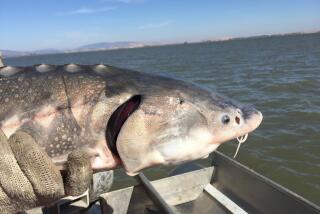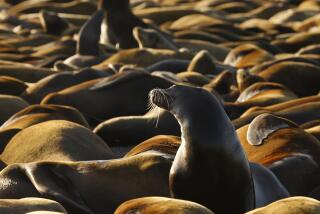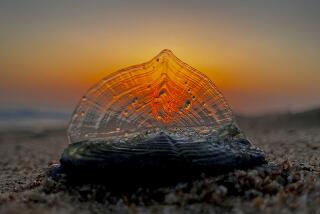Making a grunion run for science

In the darkness of a new moon, a dozen black-crowned night herons landed on a San Pedro beach and stood like sentinels facing the open ocean.
“That’s a good sign,” whispered marine biology researcher Jenn Corpuz, 26. “The herons know there is something coming.”
Suddenly, the surf shimmered with flashes of silver, and a few small, slender fish wriggled on shore, as if to size up the situation. Then thousands of fish began riding in on the swells and piling up on the beach in writhing clots. “Grunion!” she said. “Turn on your flashlights, everybody!”
About 400 onlookers dashed to the shore to witness the reproductive mayhem of Leuresthes tenuis, the iconic Southern California fish that leaves its briny realm to mate on the sand.
They also were watching the launch of a scientific attempt to establish the world’s first sustainable captive population of grunion -- a lofty goal for California marine aquariums. A half-dozen researchers and volunteers in white lab coats and cutoffs waded into the surf with plastic buckets, collecting as many as possible, then gently coaxing eggs and sperm into specimen vials before setting them free.
For several hours, the tiny strip of intensely urbanized beach next to one of the world’s busiest ports was a landing zone for wave after wave of the 6-inch night-time spawners: vibrant, vulnerable and acutely aware they had little time to complete their urgent business.
In the center of the action was Kiersten Darrow, research curator at the Cabrillo Marine Aquarium, and the team specially trained to use both hands to squeeze out grunion eggs and milt without harming the wrigglers.
Some of the pinkish gooey results were blended in a plexiglass bucket to fertilize the eggs on the spot. Other samples were hustled to the aquarium laboratory a few hundred yards away to be flash-frozen by dipping the specimen vials in a tank of liquid nitrogen -- which is slightly warmer than the surface of Pluto -- and stored in an ultra-cold refrigerated biological archive.
Cryo-preserved samples will be revived as needed by carefully heating them up, first with dry ice, then with icy saline solution and finally with cold ocean water.
“We’ll get fertilization rates of about 10%,” Darrow said, “which is fine for our purposes.”
The Cabrillo Aquarium, which sports a pale blue logo of a grunion riding a wave, has always been known as grunion central. But raising the fish in captivity has proved more challenging than expected. A school of year-old grunion fertilized in captivity and now on display at the aquarium in a large tank are only half their normal size, and suffer from a bacterial infection.”These fish don’t do well in captivity,” Darrow said. “So we’re starting a grunion fertility clinic with a bank of cryogenically preserved sperm and eggs with which we can produce fish year round.”
It is an ideal site for such an undertaking. The grunions’ mating pageant is their most astonishing trait, and the beach fronting the aquarium -- the only sandy beach for miles in either direction -- works like a magnet, pulling them in by the thousands at high tide, often around midnight.
Last week, the waves slapped hard on the beach and then feathered, giving way to the sound of a popcorn machine as thousands of grunion flopped and shimmied on the wet sand. It’s illegal to catch grunion in April, so the hundreds of spectators gawked and gasped as the fish performed their ancient ritual.
Females drilled tail-first into the semi-fluid sand to create nests in which they lay about 3,000 bright orange eggs. Males sidled up to the half-buried females, then curved their bodies and emitted milt to fertilize the eggs.
After spawning, the males retreated to the ocean. They were followed by the females, which squirmed mightily then popped out of their nests like corks from a bottle to catch the first available wave back to sea.
Dozens of shiny examples washed right up to Kris Berggren’s feet. “I’ve seen salmon spawning, but I’ve never seen anything like this before,” said Berggren, 48, who drove to San Pedro from Riverside with a group of young children. “Oh, my. Incredible.”
The aquarium’s grunion project was only a small part of a renaissance of interest in the extraordinary life cycle of the creatures about which surprisingly little is known, said Karen Martin, a professor of biology at Pepperdine University and an expert on the fish.
“The more we learn about this creature,” Martin said, “the more we think, ‘Wow!’ ”
“We already know it’s the ultimate Southern California fish,” Martin added with a smile, “in that it likes to hang out at the most beautiful beaches and surf and have a great time with its friends.”
Martin was only half-kidding. Grunion range from San Francisco Bay to Baja California and generally inhabit near-shore waters to a depth of about 60 feet. They leave the water to spawn during spring and summer months. For four consecutive days, beginning on the nights of full and new moons, spawning occurs just after the highest tides on sandy beaches and continues for several hours.
The eggs take about 10 days to incubate during lower tides, and are ready to hatch when the rising surf returns and washes away the sand.
Grunion spawn at the end of their first year. A tiny fraction reach adulthood. Scientists estimated that only one male and one female per 30,000 eggs survive long enough to become parents.
“Grunion are prey fish -- almost everything eats them. Sea lions, sharks,” said aquarium laboratory assistant Andres Carrillo, 25. “I fried some up and ate them myself. Once. Tasted like mackerel.”
On land, grunion are at the mercy of predators ranging from plovers, which feast on incubating eggs, to raccoons. At San Pedro, as the herons flew off with squirming grunion in their beaks, feral cats prowled nearby.
A century ago, grunion were the objects of a unique recreational fishery. During a typical grunion roundup, people set out in frantic grab parties, using colanders, window curtains, bedsheets and trousers with their legs tied at the bottoms to scoop them up. By the late 1920s, the fishery was showing signs of depletion and regulations were later passed to close grunion season in April and May.
In recent years, many public beaches have stopped grooming the sand with bulldozers during spawning season to avoid disturbing incubating eggs.
Today, grunion populations, although not large, are stable.
Peering through a night-vision scope as grunion kept pouring onto the beach, Martin said, “We’re seeing more runs, and they are lasting longer and taking up wider sections of beaches.
“This run, for example,” she said, “is really nice.”
Yet no one can say with certainty what happens to grunion at sea. Also unknown is exactly what conditions are required for grunion “scouts” to trigger a mass landing.
“No tracking study has been done on these fish,” Darrow said. “No one knows where they go after spawning. They effectively disappear.”
The mysteries surrounding the fish made them all the more intriguing for a video crew broadcasting a live feed of the grunion run to children gathered at the Nausicaa marine environment center in Boulogne, France.
During a question-and-answer period, one of the children in France asked a fundamental question: “What does it feel like to squeeze a grunion with your bare hands?”
“Slippery and hard to hold,” Darrow said.
More to Read
Sign up for Essential California
The most important California stories and recommendations in your inbox every morning.
You may occasionally receive promotional content from the Los Angeles Times.











